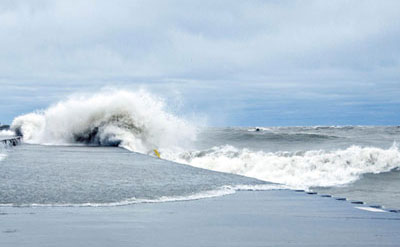Storm surges are caused by hurricanes that push water to the shore with such power that it turns the water into a wall of destruction. In fact, this wall of water can appear in mere minutes if the hurricane is strong.
Storm surges move swiftly, are very powerful, and can even happen before the hurricane comes. According to government officials, a cubic yard of sea water weighs more than 1,700 pounds, a tremendous force even in small quantities. Just a one-foot deep storm surge can sweep your car off the road, according to Wunderground.com
If you live near the coast, evacuation is the best way to avoid tragedy when it comes to hurricane protection. Those who live farther off can protect their property with hurricane safety products so debris will not cause major damage.
The presence of 3 factors should be evident for a storm surge to happen. They are:
- Movement of wind
- Wave set-up or when the waves come in faster and prevent the waves from receding
- Low pressure
Safety Tips before a Hurricane
Hurricane protection comes in many forms, but the latest technologies include impact glass and fabric shutters. These are relatively easy to install and the cost is recouped with lower incidents of property damage. If a storm surge happens, the impact glass can prevent structures from destruction because impact glass requires a solid aluminum frame and foundation. Having these types of windows will prevent wind from entering the structure and causing internal pressure.
Fabric shutters are an effective added shield against debris and strong winds or water. Although lightweight, they can be safely secured to your structure and withstand a hurricane 5 force. They are practical because they can be reused again and again. What about taping and plywood? These are just outdated, impractical, and not good for the environment since you cannot recycle them. Plywood is no longer a viable, effective method of hurricane protection when there are so many other, better ways to provide safety.
Quick Tips on Hurricane Safety:
- If you have to evacuate, do it early and avoid as much traffic as possible. You won’t regret leaving early, but you very well could regret leaving too late. Storms are unpredictable.
- Have a plan before you leave the house. Know where you are going, how long it will take you to get there, and what you need to take in case you get stranded along the way.
- Let someone know your plans.
- Don’t forget to check your lawn for loose objects
- Shut down your utilities
- Have cash, water, canned goods, and fuel. All of these will be hot commodities. You want to focus on protecting your home and your family, not grabbing basic essentials.
The last major storm surges to hit the country was Hurricane Ike in 2008 and Katrina in 2005. There was a considerable amount of devastation and damage, as well as tragic loss of life, but more would have been lost or damaged if residents living further away did not invest in hurricane protection and create their own personal hurricane shelter. Being aware of what can happen and investing in new and smart technology is one way to deal with natural calamities. As an added benefit, it increases the value of your property.




